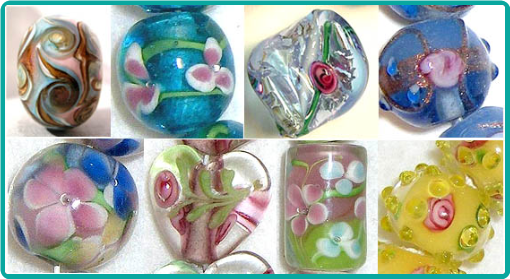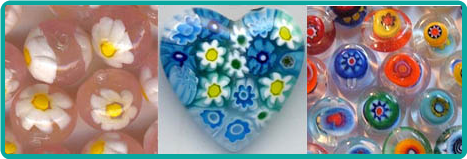 |
||||||||||||||||||||||||||||||||||||||||||||
|
 The Endless Array of Glass Beads
 Lampwork Beads
I love lampwork beads! They are little glass globes of art made by hand. Lampwork beads can be simple to intricate, from plain colored, clear or opaque, to spotted, to bumpy, and with a simple or intricate design on the interior and/or the exterior of the bead.
Lampwork beads are made by using a flametorch to heat a cane or rod of glass, then applying the molten glass around a rod called a mandrel. The bead is held over heat while it is worked on, and it takes a lot of skill to keep the bead from losing its shape. Using fine rods of glass, a lampwork artist can apply many colors of glass to the bead to create a geometric or floral design. The surface can be smooth or raised. As the bead cools, it begins to shrink on the outside, but the interior remains hot and expanded which can cause the bead to crack before it is finished. To prevent this, the bead can be placed between layers of insulation, or annealed in a kiln, where the temperature of the bead is slowly reduced. Kiln annealing makes the bead stronger and more resistant to breaking. Lampwork beads are made all over the world, and are often recognizable. Chinese, Czech, and American lampwork have quite a different look. Chinese and Czech lampwork artists generally produce multiple copies of specific styles of beads, and the skills are passed on to following generations, with businesses run by families or small factories. American lampwork artists tend to work individually in their workshops to create smaller quantities of their small masterpieces.  Wedding Cake BeadsMade famous in Venice, wedding cake beads are a type of lampwork bead. They look like little cakes with "icing" of swirls, dots, flowers and aventurine, which consists of metallic bits, usually copper, to give it sparkle.
 Millefiori Beads
Millefiori glass beads were made famous in Venice in the 1800s, and the word "millefiori"means "thousand flowers". Thin rods of different colors of glass are bundled together, with the ends of the rods forming a design, such as flowers. The bundle is fused together, then cross section slices are cut off, jelly-roll fashion. These slices are applied and melted over a glass core. The resulting bead has a three dimensional look filled with flowers or other patterns.
 Pressed GlassPressed glass is made by pressing glass into a mold. Beads of many, many shapes are made this way, such as flowers and leaves, insects, animals, rectangles, tubes, hearts, cubes and so much more. Imprints can be pressed into the bead, such as the veins on the leaves, then filled with a contrasting color. They can be opaque, transparent, or a mix of both. Czech pressed glass is of the highest quality and is what I primarily use in my designs.
 Blown GlassThese are hollow beads formed by blowing through a glass tube into a glob of melted glass at the other end. The tube is turned over a flame as the bead shape is created.
 CrystalCrystal is glass that contains lead and causes the glass to refract light. Crystal glass was invented in England in the 1600s when lead oxide was added to glass, which is made of a mixture of silica and alkali. The lead added to the glass made it stronger so that it could be cut and engraved. The lead content of crystal can be anywhere from 6% to 33%. Crystal drinking glasses are leaded, as are crystal beads. Swarovski crystals, also known as Austrian crystals, are famous and occupy the majority of the world's market for crystal beads. They are named for Daniel Swarovski, who in the 1800s, invented a machine to cut glass. Swarovski crystals have sharply defined faceted edges, that combined with the lead content, add to their sparkle. Although crystal can be cut by hand, today's crystals are cut by precision machines, then they are polished.
 Fire Polished Faceted BeadsFirepolished beads are often called crystals because they are faceted and reflect light, but they do not contain lead. They are hand or machine cut with any number of facets, then they are heated so that the edges are smoothed. The faceting on firepolished beads has a softer look than leaded crystals, but they have wonderful light refraction and come in beautiful colors. Many contain two or more colors blended together, and some have a core of a different color or material. For example, the core can contain real metals such as copper, gold or silver, which add more sparkle. Many different finishes have been created for firepolished beads. An "AB" finish means "Aurora Borealis". It gives the bead a rainbow effect as it reflects light. Finishes can be a full-coat or partial-coat and include "lustre", "pearl", "picasso", "matte", "metallic" and many others. The Czech Republic is known for producing the majority of firepolished beads and they are of excellent quality.
 Glass and Crystal PearlsI use both glass and crystal pearls in my jewelry. They are both covered with a pearlized coating, but glass pearls are unleaded, and crystal pearls are leaded, just like faceted crystal beads. The pearlized coating on crystal pearls is more resistant to wear than on glass pearls. I use high quality glass pearls from the Czech Republic and Japan, and crystal pearls made by Swarovski.
 Vintage and Antique Beads
According to a local bead shop owner, vintage beads are at least 20 years old. They can be previously used, but in the bead market, vintage beads are often never-used stock. They have been sitting in bags and boxes in an old bead factory or warehouse somewhere "ripening" with maturity. They are sought after because the designs are discontinued and represent a bygone era. Many Czech, German, Austrian and Japanese vintage beads are found on the market. Some of my designs incorporate vintage beads. Beads of 100 years or older are antique beads, and are more rare. They are often found in estate sales on old clothes or in button tins.
Copyright © 2003 - 2017 Bead Euphoria All Rights Reserved
|
|||||||||||||||||||||||||||||||||||||||||||











